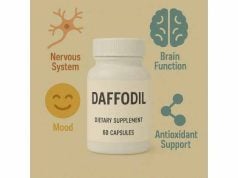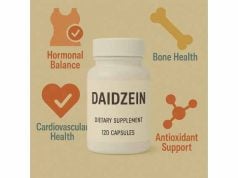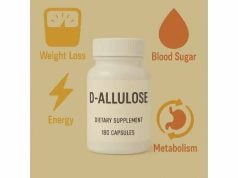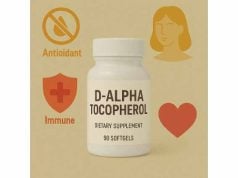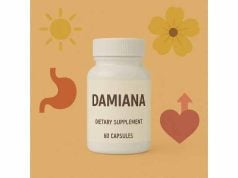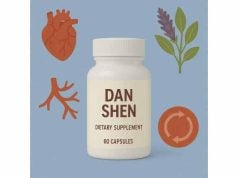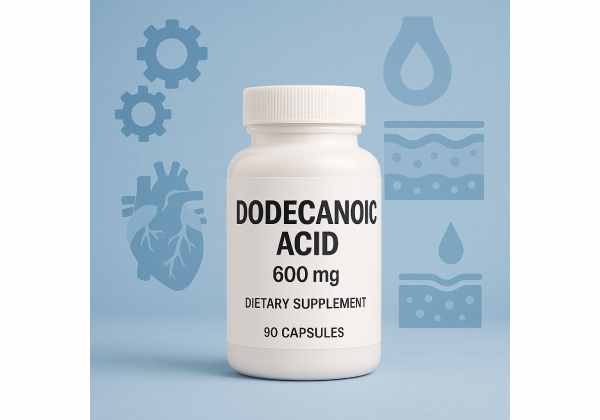
Dodecanoic acid—better known as lauric acid—is a 12-carbon saturated fatty acid (C12:0) that occurs naturally in coconut and palm kernel oils, dairy fat, and some edible insects. In industry, it’s a building block for soaps, surfactants, emulsifiers, lubricants, and even certain phase-change materials. In nutrition, lauric acid sits at the intersection of “medium-chain” chemistry and everyday eating: it metabolizes differently from many longer saturated fats, yet in common foods (notably coconut oil) it still behaves like saturated fat in blood lipid studies. That dual identity is why you’ll see both enthusiasm and caution attached to it. This guide explains what lauric acid is, where it’s useful, what the human evidence shows (and doesn’t), how to think about intake from foods and supplements, and who should steer clear or be especially careful.
Fast Facts About Dodecanoic Acid
- Found abundantly in coconut oil (roughly 40–50% of its fatty acids) and used widely in soaps and surfactants.
- Lab and animal data suggest antimicrobial actions; human clinical benefits remain limited and context-specific.
- Practical dietary example: 1 tablespoon coconut oil (~14 g fat) supplies about 6–7 g lauric acid.
- Safety caveat: replacing unsaturated oils with coconut oil tends to raise LDL cholesterol versus non-tropical vegetable oils.
- Avoid high-lauric strategies if you have high LDL, familial hypercholesterolemia, or your clinician has advised limiting saturated fat.
Table of Contents
- What is dodecanoic acid and how it behaves
- Does dodecanoic acid have health benefits?
- How to use dodecanoic acid day to day
- How much dodecanoic acid per day?
- Safety, risks, and who should avoid it
- Evidence snapshot: what studies actually show
What is dodecanoic acid and how it behaves
Dodecanoic acid (lauric acid) is a saturated fatty acid with 12 carbons and the chemical formula C₁₂H₂₄O₂. At room temperature it’s a white, waxy solid with a melting range around the mid-40s °C. In nature, it appears in many fats in small amounts, but it is unusually concentrated in coconut oil and palm kernel oil, which is why these are sometimes called lauric oils. In coconut oil specifically, lauric acid typically makes up roughly half of all fatty acids, with the exact proportion varying by cultivar, growing conditions, and processing.
Chemically, lauric acid is often grouped with medium-chain fatty acids (MCFAs) because of its chain length. That classification matters because MCFAs are absorbed and transported somewhat differently than long-chain fats: a larger fraction can move directly to the liver through the portal vein and be oxidized for energy. Still, lauric acid sits at the borderline of this category. Some nutrition scientists treat it as a “longer MCFA” whose real-world metabolic behavior can resemble longer saturated fats in typical mixed meals. This nuance explains why products marketed as MCT oil frequently exclude lauric acid (favoring the shorter C8 and C10), while whole-food lauric sources like coconut oil don’t always deliver the same metabolic profile as purified MCTs.
Outside nutrition, dodecanoic acid underpins a wide slate of industrial uses:
- Soap and surfactant manufacture: Neutralizing lauric acid with sodium or potassium yields sodium/potassium laurate, key bases for cleansing bars and liquid soaps prized for quick lathering and hard bars.
- Personal care formulations: Emulsifiers, emollients, and esters derived from lauric acid (e.g., isopropyl laurate) improve skin-feel and spreadability.
- Food and pharma excipients: Laurate esters can function as antifoaming agents, release modifiers, and lubricants.
- Phase-change materials (PCMs): Thanks to its sharp melting transition near body-adjacent temperatures, lauric acid is used in thermal energy storage blends.
Key takeaways: dodecanoic acid is a workhorse molecule—common in manufacturing, abundant in certain foods, and metabolically interesting. But “interesting” doesn’t automatically mean “beneficial” across all health outcomes; context and form (whole oil vs purified MCTs vs isolated laurate) matter.
Does dodecanoic acid have health benefits?
In vitro and animal findings highlight lauric acid’s antimicrobial activity against several bacteria and some fungi, as well as potential effects on cellular signaling, inflammation, and energy metabolism. Its monoglyceride, glycerol monolaurate (monolaurin), is particularly studied for antibacterial and antiviral actions in lab systems. There is also mechanistic work on laurate’s role in ketone production and rapid hepatic oxidation when delivered as part of medium-chain triglycerides.
However, translating these mechanisms to human benefits is not straightforward. What most people ingest is coconut oil (a complex mix where lauric acid dominates) or a tailored MCT oil (usually C8/C10). The clinical evidence diverges:
- Lipids and heart markers: Randomized trials and meta-analyses show that replacing non-tropical unsaturated oils with coconut oil tends to raise LDL cholesterol, although usually less than butter. These findings repeatedly appear when coconut oil is compared with olive, safflower, canola, or soybean oils. HDL cholesterol may rise modestly too, but the LDL increase is the clinically important signal.
- Weight and glycemia: When compared with other oils in controlled diets, coconut oil has not shown superior effects on body weight, waist circumference, glucose, or inflammation markers.
- Brain and energy claims: Purified MCTs (especially C8) can raise circulating ketones and are being explored as adjuncts in specific scenarios, but this should not be conflated with taking coconut oil or isolated lauric acid for broad cognitive or energy benefits in healthy adults.
- Immune or infection outcomes: Human trials showing clear clinical benefit from oral lauric acid or monolaurin are limited. The antimicrobial story is strongest in vitro and in animal models; it supports plausibility but does not establish outcomes like fewer infections in everyday use.
Bottom line: lauric acid has credible mechanisms and clear non-nutritional uses. In human nutrition, it behaves like saturated fat when delivered via coconut oil in typical amounts, and the most consistent clinical signal is higher LDL versus using unsaturated oils. If you’re choosing fats for heart health, the evidence still favors unsaturated options. If you’re exploring MCTs for specialized reasons, be aware many MCT products are purposefully low in lauric acid because shorter chains (C8/C10) drive the effects those products target.
How to use dodecanoic acid day to day
At home (culinary): Most people encounter lauric acid through coconut products. Virgin and refined coconut oils have different flavors and smoke points, but both are saturated-fat-rich and laurate-dense. For general cooking, it’s reasonable to think of coconut oil as an occasional fat for specific recipes rather than a heart-healthy default. Use it when you want its flavor or solid-fat functionality (e.g., certain pastries), and rely on olive, canola, or other unsaturated oils for routine sautéing and salad dressings.
In supplements:
- MCT oils are typically blends of C8 and C10 with minimal lauric acid. They’re marketed for quick energy and ketosis support. If you specifically want lauric acid, read labels—many MCT products deliberately avoid C12.
- Monolaurin capsules or powders are sold for “immune support.” These products supply a lauric-derived monoglyceride, not lauric acid itself. Evidence for routine use in healthy adults is limited; no authoritative human dosing standard exists.
- Isolated lauric acid as a supplement is uncommon; when present, it is typically part of a broader fatty-acid blend or functional food.
In personal care and household products: You’ll see laurate derivatives in cleansers, shampoos, conditioners, and lotions as surfactants and emollients. These are topical uses; their safety assessment and regulatory status differ from food uses.
In specialized applications:
- Sports and clinical nutrition: Certain formulas include MCTs for rapid energy or malabsorption contexts. These nearly always emphasize C8/C10.
- Formulation science: Laurate esters can improve spreadability and stability; formulators choose among chain lengths to balance cleansing, mildness, and viscosity.
- Thermal storage: Lauric acid-based PCMs appear in niche energy applications (e.g., temperature-stabilizing packs). This has no bearing on nutrition but illustrates laurate’s physical chemistry.
Practical guidance for everyday eaters:
- Keep coconut oil as a sometimes fat; enjoy it for taste or texture, not for cardiometabolic benefit.
- For ketone-oriented experiments, know that C8-dominant MCT products are not the same as coconut oil or lauric acid, and they carry their own GI tolerance limits.
- If a product markets lauric acid for immunity, adopt a skeptical, evidence-seeking stance and consult a clinician if you have conditions or take medications.
How much dodecanoic acid per day?
There is no established recommended daily allowance or clinically endorsed “dose” of lauric acid for the general public. Instead, make decisions using two anchors:
1) Dietary saturated fat limits. Public health guidance recommends limiting saturated fat (the category lauric acid belongs to). For most people, that means <10% of calories from saturated fat per day (about 22 g on a 2,000-kcal diet), and 5–6% for individuals needing to lower LDL cholesterol (about 11–13 g on 2,000 kcal). Since coconut oil is ~90% saturated fat and about half of that is lauric acid, a single tablespoon (~14 g fat) delivers ~12–13 g saturated fat and ~6–7 g lauric acid—which can consume your daily saturated-fat budget if you follow stricter heart-health targets.
2) Real-world equivalence instead of “supplement doses.” If you’re curious about what typical intakes look like in food terms:
- 1 teaspoon coconut oil (≈4.5 g fat) → roughly 2–3 g lauric acid.
- 1 tablespoon coconut oil (≈14 g fat) → roughly 6–7 g lauric acid.
- MCT oil serving (≈10–15 g) → varies; many contain little to no lauric acid (C12) because they emphasize C8/C10. Check the specification if laurate exposure matters to you.
What about monolaurin? There is no authoritative human clinical dosing standard for monolaurin to prevent or treat illness. Labels sometimes suggest hundreds of milligrams to a few grams per day, but such amounts are product claims, not clinical guidelines. If you’re considering monolaurin for a specific medical reason, involve your clinician.
Practical patterns aligned with evidence and safety
- If you enjoy coconut oil for flavor, keep portions modest, and balance your overall day with unsaturated fats (olive oil, nuts, seeds, avocados, fish).
- If you’re testing MCT products for workout fueling or GI malabsorption scenarios, start low (e.g., 5–10 ml) to gauge tolerance; recognize this is not lauric-focused.
- If heart health is a priority, prioritize unsaturated oils for daily cooking; treat coconut oil like chocolate—worth it for a specific taste, not a default fat.
Safety, risks, and who should avoid it
General safety: Dodecanoic acid and its common derivatives are widely used in food, cosmetics, and household products. In pure form it can irritate eyes and skin; standard lab and manufacturing controls (gloves, eye protection, ventilation) apply. In foods, the key concern isn’t acute toxicity—it’s the cardiometabolic impact of raising LDL cholesterol if lauric-rich fats displace unsaturated oils in your diet.
Who should be cautious or avoid high-laurate strategies
- People with high LDL cholesterol, known atherosclerotic cardiovascular disease (ASCVD), familial hypercholesterolemia, or those advised to keep saturated fat to 5–6% of calories. In these contexts, routine coconut-oil use can make lipid management harder; unsaturated oils fit better with treatment goals.
- Individuals with GI sensitivity to fats or to MCTs; while laurate itself isn’t the usual culprit (C8/C10 often cause the GI upset), coconut and MCT oils can both trigger loose stools, cramping, or nausea at higher intakes.
- People taking fat-soluble drug formulations or with malabsorption disorders should consult their clinicians when introducing any concentrated fat source; dosing and timing can matter.
- Allergies: True allergy to lauric acid is rare; coconut allergy exists but is uncommon. If you’ve had reactions to coconut products, avoid laurate-rich foods and discuss testing with an allergist.
Medication interactions: No well-established, clinically significant drug interactions are tied specifically to lauric acid at dietary levels. The broader issue is lipid control—if you’re on lipid-lowering therapy, using coconut oil in place of unsaturated oils can push LDL upward, working against your medication’s goals.
Pregnancy and lactation: Coconut foods are common in many cuisines and culinary amounts are generally considered acceptable. For supplement-level intakes (e.g., large boluses of MCTs or monolaurin), discuss with your obstetric clinician; targeted safety data are limited.
Environmental and ethical notes: Coconut and palm kernel supply chains can involve ecological and labor concerns. If these matter to you, look for certifications (where relevant) and brands with transparent sourcing.
Red flags in marketing
- Claims that coconut oil “improves cholesterol” or that lauric acid will “support immunity” in healthy adults without clinical trial evidence in humans.
- Confusing MCT oil and coconut oil as interchangeable (they are often not).
- Presenting monolaurin dosing as if it were an established medical guideline.
Evidence snapshot: what studies actually show
Composition and metabolism
Contemporary reviews of medium-chain triglycerides summarize lauric acid’s place among C6–C12 fatty acids and why manufacturers often prioritize C8/C10 in MCT products (rapid absorption, ketogenesis). These reviews also reinforce that definitions of “MCT” vary across industry and research, and that lauric acid’s borderline chain length can blur the line between “medium” and “long” in mixed diets. This helps explain why purified MCT oils and coconut oil show different metabolic effects.
Coconut oil vs other oils
A widely cited systematic review and meta-analysis of clinical trials reports that coconut oil raises LDL cholesterol relative to non-tropical vegetable oils, although less than butter. This conclusion has been reiterated in recent reviews focused on cardiovascular risk, which emphasize that coconut oil does not outperform unsaturated oils on lipids, blood pressure, or inflammation markers. Together, these findings argue against treating lauric-rich coconut oil as a cardioprotective fat.
Antimicrobial and biomedical applications
A recent narrative review collects lauric acid’s proposed antimicrobial, anti-inflammatory, and drug-delivery roles and highlights the preclinical enthusiasm around monolaurin and laurate-based formulations. The authors also note gaps: many claims stem from in vitro studies or animal models, and more human trials are needed to establish clinical dosing, benefits, and safety in specific conditions.
Dietary guidance context
National nutrition guidance maintains the long-standing recommendation to limit saturated fat (including lauric acid) to <10% of calories for the general population, and to 5–6% for people who need to lower LDL cholesterol. These limits don’t single out lauric acid; they reflect the weight of evidence linking saturated fats as a class to LDL-raising effects. For individuals, the practical implication is to prioritize unsaturated oils for daily use and treat coconut oil as an optional flavor or texture choice, not a default staple.
Confidence levels
- Strong evidence (human trials/meta-analyses): Coconut oil raises LDL vs unsaturated oils.
- Moderate mechanistic support, limited clinical data: Antimicrobial and immune narratives around lauric acid/monolaurin.
- Context-dependent: Ketogenic or rapid-energy claims apply mainly to C8/C10-focused MCTs, not necessarily to lauric-dense coconut oil.
- Consensus guidance: Keep saturated fat within recommended limits; swap in unsaturated oils to support cardiometabolic goals.
If you’re deciding how lauric acid fits your routine, let your health objective drive the choice: flavor and culinary function (use coconut oil sparingly), targeted ketosis (consider C8-rich MCTs if appropriate), or skin/hair care (laurate derivatives are commonplace and useful). For disease prevention or treatment, lean on evidence-based dietary patterns and clinician guidance rather than isolated fatty acids.
References
- Lauric Acid | C12H24O2 | CID 3893 – PubChem 2025 (Reference)
- Triglycerides of medium-chain fatty acids: a concise review 2022 (Review)
- The Effect of Coconut Oil Consumption on Cardiovascular Risk Factors: A Systematic Review and Meta-Analysis of Clinical Trials 2020 (Systematic Review)
- Coconut Oil and Cardiovascular Disease Risk 2023 (Review)
- Dietary Guidelines for Americans, 2020-2025 2020 (Guideline)
Disclaimer
This information is for education, not medical advice. It is not a substitute for diagnosis, treatment, or personalized nutrition guidance. Talk with your healthcare professional before using coconut oil, MCTs, monolaurin, or any concentrated fat source—especially if you have high LDL cholesterol, cardiovascular disease, lipid disorders such as familial hypercholesterolemia, diabetes, gastrointestinal conditions, or you are pregnant or breastfeeding. If you’re under treatment for elevated cholesterol, prioritize unsaturated oils unless your clinician advises otherwise.
If you found this guide helpful, please consider sharing it on Facebook, X (formerly Twitter), or your preferred platform, and follow us for future evidence-based articles. Your support helps us continue producing high-quality, people-first content.

